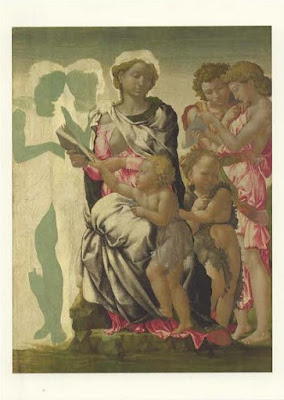More treasures of pleasures past...
1) STILL LIFE ON CORNER OF A MANTLEPIECE (1914) - Vanessa Bell
I bought this at the Dulwich Picture Gallery at their impressive Vanessa Bell exhibition in 2017 which sought to celebrate her as an artist rather than as merely a member of the Bloomsbury Group.
Painted in her living room in Gordon Square, the composition shows her continued interest in post-impressionism, with a spray of paper flowers from The Omega Workshops providing inspiration for the painting and it's harmony of colours.
2) THE VIRGIN AND CHILD WITH SAINT JOHN AND ANGELS (circa 1494) - Michelangelo
As this painting is in the National Gallery collection, I presume I bought it there
as part of a Renaissance exhibition. It is understood to be one of the earliest surviving paintings of Michelangelo and, due to it's inclusion in the 1857 Manchester Art Exhibition, it is known widely as 'The Manchester Madonna',
Odd that if it is one of his earliest paintings he could never be bothered to finish it! But it's the unfinished state that appeals to me, the ghostly angels at the left of the painting and the unpainted sections of the Virgin's cloak give it a solarised look that looks almost surrealist against the fully realised infant Christ and John the Baptist. I like the small detail of the infant Christ reaching for the book that the Virgin is trying to keep away from him... As usual, Michelangelo's figures have a marble-like solidity. And on the subject of Michelangelo's marble...
3) THE PIETA BANDINI (Detail) (1547-1555) - Michelangelo
This
was bought at the Museo dell' Opera dei Duomo in Florence; it's a strange museum which houses most of the original works once in the Duomo... like, they could just move them back? Michelangelo struggled with the sculpture for eight years before he damaged it, allegedly, in a fit of wilful destruction stating that the marble was flawed. It is widely believed that the looming figure of Nicodemus is a self-portrait of the artist, then in his mid-seventies.
Michelangelo's damage was extensive but was mostly restored by a sculpter named Tiberio Calcagni who had helped the Master with some of his commissions. It had been allocated to Calcagni by Francesco Bandini, prelate of Siena, who had acquired it when Michelangelo left it with one of his servants. It was originally to be used as decoration for Michelangelo's tomb but his unhappiness with it put paid to that. The supporting figures of Mary Magdelene and the Virgin Mary are fairly unremarkable but the figure of Christ has a slippery solidity while the figure of the standing Nicodemus / Michelangelo commands the attention.
4) PORTRAIT OF MARIE ADELAIDE OF FRANCE IN TURKISH COSTUME (1753) - Jean-Etienne Liotard
I bought this at the Uffizi in Florence where the French Princess reads on, unconcerned at the steady stream of visitors to the gallery. Liotard was fascinated by all things Turkish and he had a penchant for dressing his subjects in exotic clothing. What I love about this is the thought that Princess Marie-Adelaide got all dressed up to go to a costume party then changed her mind and started reading on her couch!
Marie-Adelaide was the fourth daughter of Louis XV and lived at Versailles up until the Royal family were taken to live in Paris at the start of the revolution. She never married due to a dearth of available Catholic princes but was a favourite of her father and as such, took a dislike to his official mistresses Madame de Pompadour and later Madame du Barry. She attempted to recruit her niece by marriage Marie Antoinette to have du Barry socially ostracised but failed when the Dauphine spoke to du Barry. This put Marie Antoinette on the Princess' hate list too. She and her sisters managed to escape to Italy before the reign of terror and died in exile aged 67.
5) THE SITTING ROOM, MONK'S HOUSE, RODMELL, EAST SUSSEX
A very happy memory is visiting Monk's House on a sunny day in 2014. Virginia and Leonard Woolf bought the house in an auction in 1919 for £700 and over the years, as they both became successful, they started making improvements to the rudimentary interior and garden. They lived increasingly at Monk's House during the 20s and 30s due to Virginia's recurring mental breakdowns which were exacerbated by London life, and became a much-loved part of their life. After Virginia's suicide in 1941, Leonard lived on at Monk's House until his own death in 1969.
Now operated by the National Trust, the sitting room is one of the ground-floor rooms available to view and it is a particular thrill to walk around it's stone-flagged floors and wondering how on earth the long and lanky Lytton Strachey managed to not brain himself on the low ceilings. The sitting room has light green walls, painted by Virginia, which gives the room a cool, subterrranean feel. I'd love to visit again.































































